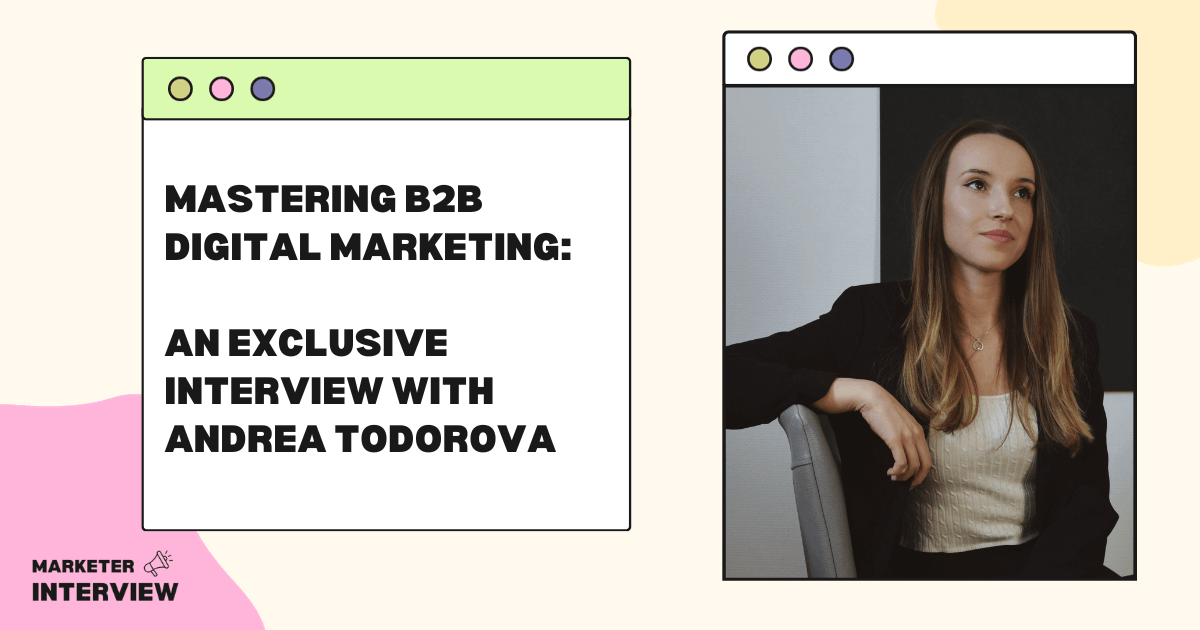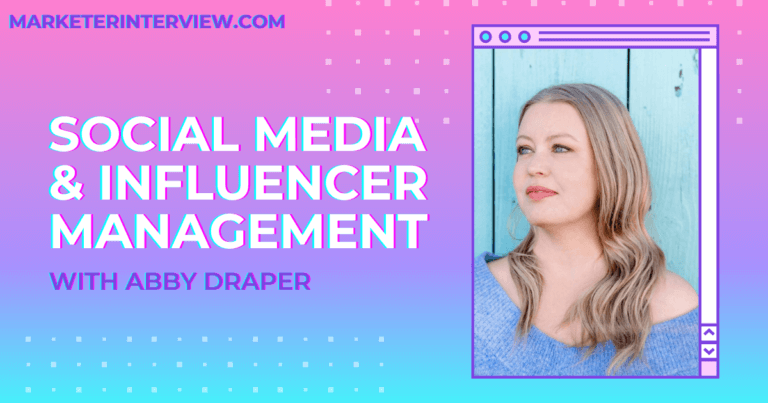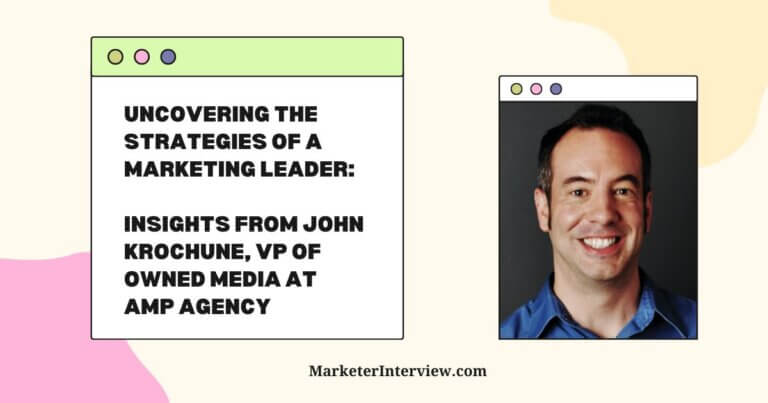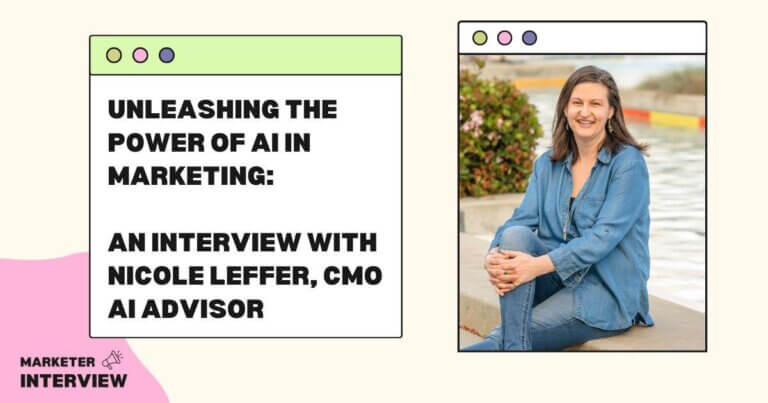Mastering B2B Digital Marketing: An Interview with Andrea Todorova
Welcome to Marketer Interview, the go-to platform for in-depth conversations with remarkable marketing professionals.
Today, we are delighted to have Andrea Todorova, the Co-founder and B2B Marketing Strategist at Diligent Studios, with us.
Andrea has expertise in B2B digital marketing strategies, web and landing page optimization, and paid media campaigns. Her work is deeply rooted in customer research, ensuring their digital marketing efforts resonate with the intended audience.
Let’s jump into Andrea’s journey and insights into the marketing world.
Contents
- 1 Can you share your journey into the marketing world and how you became a co-founder of Diligent Studios?
- 2 Diligent Studios is known for its focus on customer research. Could you elaborate on how this research shapes your digital marketing strategies?
- 3 What, in your opinion, sets apart successful B2B digital marketing strategies from the rest?
- 4 Websites and landing pages are crucial in digital marketing. How do you approach them from a marketing perspective to maximize their impact?
- 5 Could you give an example of a particularly challenging B2B digital marketing project you’ve worked on and how you overcame the hurdles?
- 6 Paid media plays a significant role in modern marketing. What’s your approach to creating effective paid media campaigns, and which platforms do you find most promising?
- 7 How do you ensure that paid media campaigns align with the customer research-driven approach you follow at Diligent Studios?
- 8 What marketing tools and software do you and your team rely on to streamline your work and achieve your goals efficiently?
- 9 In the fast-evolving landscape of digital marketing, how do you stay updated and adapt to new trends and technologies?
- 10 What advice would you give aspiring marketers who want to excel in the B2B sector and follow a customer-centric approach?
- 11 Can you share a project or campaign that you’re particularly proud of, and what were the key factors that made it successful from a marketing perspective?
It all started back in 2017 when I got my first freelancing job together with my partner, Niko. We were working on several projects with an agency and directly with clients. This is how I got my first real experience in the digital marketing world. It was probably at that point I fell in love with it and decided to continue exploring what else it had to offer.
Shortly after, I got a job at Amgen – the American multinational biopharmaceutical company – where I worked in the marketing department. At the time, I was also doing my bachelor’s thesis on digital marketing.
Following my graduation, I hit a new milestone in my career. I joined a Slovenian scale-up – Visionect – where I got a lot of experience in the tech world. I worked as a Customer Success Manager, and the nature of the job was working closely with customers. It showed me how important it is to analyze customer behavior and understand their unique needs. Every step of my journey gradually led me to where I stand today.
Over the next few years, I finished my Master’s studies in entrepreneurship and graduated with a thesis on social media usage trends in SMEs. At the same time, my partner Niko and I started our journey with Diligent Studios. We’re well into our fourth year of working under this brand name.
Honestly, I never imagined that one day I’d have my own business. But it made sense since the first job we took together with Niko. He is a developer and designer, while I’m a marketer. We have this unique set of capabilities that empowers us to help our clients holistically while preserving the benefits of a boutique agency’s approach.
I’m simply glad we leaped.
Diligent Studios is known for its focus on customer research. Could you elaborate on how this research shapes your digital marketing strategies?
Customer research is critical to the marketing strategy and to a wide range of options. It is true, especially in the B2B sector. The buying processes in this sector are longer and more complex, primarily because more stakeholders are involved. The decisions are made rationally, considering many business factors in play.
However, there are also emotional factors that can have an even more significant influence. Each of the buying committee members is ruled by their motivators, pains, fears, frustrations, preferences, and goals they have in the workplace.
This means that the B2B marketer needs to get to the core of the common denominators that dictate the buying decision. This is the only way to create a strategy that will shape the right messages and create a plan for their distribution. A strategy that will cover all stages of awareness and provide the right content based on customer needs and their role in the buying decision.
You cannot control the buying decision or the buyer’s journey. But what you can do is influence it by getting your message across all the right touch points. And the only way to do this is by studying your customers.
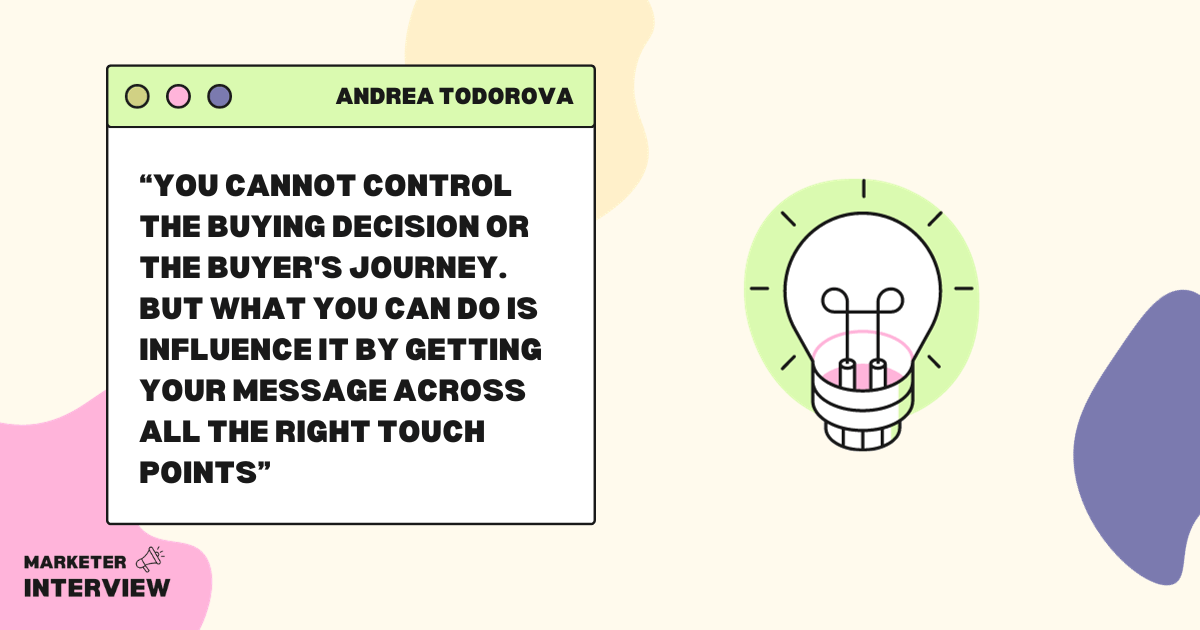
What, in your opinion, sets apart successful B2B digital marketing strategies from the rest?
Successful B2B digital marketing strategies aim to achieve goals aligned with the business. These goals are realistic and measurable. And there’s a clear plan of how they will be achieved. This is very important because it sets the general direction and purpose of the marketing efforts. It coordinates not only the activities that are going to be performed but also the stakeholders involved.
Successful strategies are also based on customer insights and are continuously updated. The need for updates comes from the fact that with time, the business grows and takes new directions, the trends change, and the customers change their behavior. And the strategy needs to evolve together with these changes. Successful strategies are also adjusted and upgraded based on the continuous results and analytics of the running efforts.
And finally, successful strategies are not only on paper or in some digital documents. Instead, they are also implemented and executed. And most importantly, they’re adopted by the whole business.
Websites and landing pages are crucial in digital marketing. How do you approach them from a marketing perspective to maximize their impact?
Nowadays, you can create a site or a landing page in just a few clicks. With all the advanced tools and platforms, it’s easier than ever. However, the sole creation of a site and the creation of a marketing asset should not be confused.
If you want to create an impactful website or landing page, one of the first things you need to consider is what you want to achieve with it. Consider what the goals and objectives are, who it is for, how it fits into the buyer journey, etc. A significant portion of this should already be covered in the digital marketing strategy. So what I’m trying to say is that the website or landing page should be a product of your customer knowledge and of the stranding of your digital marketing goals.
Once the prospect lands on your site, you want them to identify with what you have to say. Or if they’re not the right fit, you want them to recognize it immediately. The website should reflect your value prop and include messaging that resonates with the right audience. To create such messaging, you should address your audience’s pain points, explain how to solve them, and highlight the benefits your solution will provide. Then, finally, respond to any objections they might have. So basically, you’d want your audience to understand who the solution is for, what it is, how it solves the problem, and what they’ll gain from using it.
For example, an email-sending platform for small businesses would address the simplicity of usage, as the most significant pain point for them would be the lack of knowledge, skills, and time for email marketing. The benefits would be sending emails with minimal effort and with confidence, as well as building relationships with the customers. They’d then explain how this can be accomplished, which is by creating emails in just a few clicks using pre-prepared templates and personalizing them. They’d also highlight their 24/7 customer support, thereby responding to an objection, given that small businesses usually need help using the platform.
Your messaging can also be portrayed visually. In addition to good copy, there should also be a visual presentation of the product/service. I believe it is essential for the prospect to visualize what they’ll get. This could be, for instance, a feature or product image, video, or interactive demo. If you’re promoting a service, you can illustrate, for example, the problem, process, or outcome of your service.
Another thing landing pages and websites should provide is relevant content. There’s a variety of content materials prospects might need, such as educational resources, product/service information, instructions, case studies, etc. It depends on the site’s purpose and what they need to take the next step or, in other words, the desired action. Through content, you help them understand what your offer and solution are about. That’s how you can also answer any questions they might have. Or even show credibility, which is very important and can be done by providing testimonials, case studies, and success stories as proof of your capabilities.
Don’t worry if you don’t get everything right at the beginning. Even with all the research, planning, and hard work, there’s a high chance that you’ll need to make improvements down the line. After all, the websites and landing pages should constantly evolve. You just have to be agile and respond to the changing trends. You also need to measure the performance of the site and the user behavior.
This brings me to my next point – setting up and utilizing marketing tools. It’s essential to integrate your website or landing page with your marketing stack. For instance, with your CRM, email sending platform, tracking scripts such as Meta Pixel, Insights, Google Tag Manager, Hotjar, etc. This will, for example, enable you to automate marketing tasks and obtain better insights into campaign performance. It will also help you assess which variables perform well, test and compare them, better understand user behavior, and identify potential issues. As a result, you can optimize the user experience.
This was a brief explanation of how I approach websites and landing pages from a marketing perspective to maximize their impact. To summarize, you need relevant copy, compelling visuals, and quality content. You must also provide a good user experience and continue to upgrade and optimize.
But your efforts shouldn’t end here. Even if you have a great website, traffic won’t come on its own. So make sure you also have good distribution channels. For example, you can optimize your content for SEO, use social media channels to drive traffic, run paid media campaigns, etc.
Could you give an example of a particularly challenging B2B digital marketing project you’ve worked on and how you overcame the hurdles?
B2B is such a complex sector that we’ve had quite a few such projects. But if I had to choose just one, I guess it’d be creating a digital marketing strategy for a construction project management SaaS.
Not so long ago, we were hired to help grow this established business with a healthy customer base. At the time, they were promoting their product by doing outreach. Also, WOM was a vital channel but not sufficient since prospects would inquire occasionally. Once they did, they were invited to an in-person demo meeting. There was only a little product info or materials available on the website, and the prospect would get an extensive presentation only in these demo meetings or sometimes over the phone. Once they decide to proceed, the onboarding process would happen with the help of our client, also in person at their offices. This took a considerable amount of time and financial resources.
So, the main problem was growing and scaling the business. At that moment, the client wasn’t utilizing any digital channels and relying mainly on sales activities instead of marketing. So, they decided to work with us to develop their digital marketing strategy. The goal was to transfer the workload digitally regarding demand generation and capture, as well as the onboarding process.
It was a rather large and complex project, which is why we had to work closely with the client to align with their business perspective and also to get their expert insights.
First of all, we defined the ICP and estimated the potential of the target market. It was a relatively small market, but there were still plenty of opportunities to explore.
Next, we analyzed the direct competitors, which proved weak. The biggest competitor was, in fact, a substitute solution. We used this knowledge later on when we were preparing the content strategy. The client was competing with an alternative solution already incorporated into their processes to such a degree that we had to base a lot of marketing materials on comparing the two.
The product solved a problem in which there were a lot of stakeholders involved. It served a few different personas within the company. So, the next step was to study the buying decision process to understand all the roles and influencers involved. It was challenging to define and analyze all of them, but it was also the driving force that helped us grasp the bigger picture.
So we studied their jobs and how the product fits into their daily activities. Analyzing their current processes helped us detect all the struggles and frustrations they faced. And we used all of this knowledge to prepare the messaging for each buyer’s personas.
Until then, the client looked at the product and focused on its benefits. But we proved that each of the personas cares about different aspects of it. Each of them has their purpose, and it helps them solve unique pain points. The former approach used to work for our client because of one significant advantage, which is face-to-face contact. However, in the digital environment, it’s unlikely to work. You have to compensate with personalized messaging, content, and offers.
The idea was to offer the prospects all the info they require on the website, reducing the need for those in-person demo meetings. We also identified potential channels to reach these buyer personas in addition to outreach. Then, we created a content strategy.
Following that, we started optimizing the onboarding process. We automated all the steps that would allow the setup process to be completed online and as seamlessly as possible. However, we kept the in-person demo & onboarding meeting option for the more significant, profitable accounts.
As part of the content strategy, we outlined not only educative and product materials but also instructions and documentation. The idea was to unburden the support team and give the customers an option to look up these resources themselves.
Last but not least, we also made a longer-term plan that involved integrating the product into the educational sector. The idea was to make it the standard software used in the industry. It would help increase awareness and credibility. Also, the students would use and master it by the end of their studies. Then, they could start introducing and implementing it in their workplace.
And this is, in short, how we helped our client solve their growth and scalability issues.
Paid media plays a significant role in modern marketing. What’s your approach to creating effective paid media campaigns, and which platforms do you find most promising?
Paid media has proven to be a very effective channel. Our approach depends on the case. It’s different based on the stage the company is at, its budget size, its brand recognition, etc. There are a lot of determinants to consider before coming up with an approach.
In most cases, I start bottom-up. So, I look up the high-intent search terms first and determine if there’s an opportunity for search engine advertising. This approach can work for almost any business, no matter the specifics. However, there’s no guarantee, and you always need to experiment and test first before you settle on the channel or approach.
Next, I look at the site analytics, and if there’s enough healthy traffic, I like to start with retargeting campaigns. These are also good for targeting visitors that came through paid search ads. They involve targeting warm leads that have already had some kind of interaction with the brand. However, a lot of times, especially for businesses that are just starting or have not been utilizing digital channels, this is not the case – they don’t have a lot of traffic. So, I move on to other methods.
As we move higher up the funnel or the stages of awareness, I like to experiment with different content formats and offers. The goal is to create demand by spreading problem awareness, introducing a solution, presenting the product/service, and finally, building credibility. This is then the full-funnel paid media approach together with the demand-capturing activities.
As I said, it depends on the case, but there are some common denominators of effective campaigns. An example would be targeting. It’s hard to say which platforms or types of paid media are most promising and will get you in front of your target audience. You have to figure that out yourself.
The most obvious ones are social media and search engine platforms. But you can also go wider than that. If there’s a blog post that ranks first and contains a list of solutions to solve a problem, you can ask for a sponsorship to get on that list. This is another way to dominate the SERP, in addition to your blog posts and search ads. Or you can sponsor any other media like newsletters, events, or podcasts your target audience consumes.
We primarily run LinkedIn, Meta, and Google ads, though. And our approach is to craft ads that stand out. In the pool of marketing materials, ads, and sales proposals, the customer will care about those that are highly relevant to them. So, we want the ads to resonate with the target audience.
To do so, we prepare a clear copy that is usually a combination of specific pain points, benefits, and how they can be solved or achieved. The next thing that makes successful ads is the strong and appealing visual. This is, of course, applicable to ad placements that allow it. And finally, a good ad also needs a proper and actionable CTA.
So, it all comes down to understanding your audience. Plus, a little bit of creativity.
How do you ensure that paid media campaigns align with the customer research-driven approach you follow at Diligent Studios?
Well, first of all, we have a framework for conducting research and creating the strategy, which also involves planning for paid media campaigns. We study the buyer personas and the buyer journey to figure out all the touchpoints that could be covered with paid ads. The framework results in collecting customer insights that fuel all marketing activities.
Then, it’s time to test the findings. We run experiments, test different channels, double down on what works, and proceed with optimizing. Then, we continue the research by measuring and analyzing the campaign results.
What marketing tools and software do you and your team rely on to streamline your work and achieve your goals efficiently?
We use plenty of marketing tools and software. I need to figure out where to begin.
For example, we use no/low-code platforms to set up landing pages for internal purposes quickly. Then, we install GTM, GA4, and Hotjar for analytics and tracking. Sometimes, even Posthog.
For designing ads, we use Figma, Xd, and Affinity Designer. For sending emails, we rely on SendGrid, while our customer relationships are managed in Folk CRM.
For brainstorming, mind mapping, organizing research, etc, we use Miro. Something I always do is make my boards very aesthetically pleasing. This inspires and motivates me when working. Clean workspace and good organization go a long way.
I listed as many tools that came to mind, but I’m sure there’s a lot more I’m forgetting. I believe everyone should do their research and even try out a few trials to see which tools work best for them.
Once you find your ideal tools, your workflows get much smoother and easier to manage. On the other hand, these tools can also support and strengthen your marketing efforts in many ways.
In the fast-evolving landscape of digital marketing, how do you stay updated and adapt to new trends and technologies?
Something I use daily and am probably low-key addicted to is LinkedIn. I follow a lot of experts, primarily micro-influencers, who share valuable insights. From them, I learned about new approaches, perspectives, and techniques to implement and experiment with myself.
LinkedIn is my go-to source for new trends and updates, but also for networking. Since I started actively posting, I’ve met many great people from the industry with whom we exchange knowledge. I also began organizing virtual 1:1 coffee meets every Friday and will soon host the 6th one. In these meetings, we discuss practical problems, share information, or rant about B2B. It’s been a blast so far.
For tech trends and news, I rely heavily on my partner Niko, whose background is in tech. He’s very informed and up-to-date with everything that’s going on. Otherwise, I’m also a member of closed communities and periodically attend online webinars and conferences.
What advice would you give aspiring marketers who want to excel in the B2B sector and follow a customer-centric approach?
My advice would be to be critical and curious and not settle for doing something just because it’s trendy or because everybody else has been doing it for years. Get inspired by trends, other marketers, or colleagues, but use your judgment and decide for yourself. And when in doubt, run experiments.
If you want to follow a customer-centric approach, understand your customers. Research them and collect feedback directly. Make sure you ask the right questions and also know how to listen. In addition, utilize relevant tools and platforms for tracking and analytics. And once you have insights, don’t forget to put them to use.
At last, a more general advice. Don’t compare yourself to others. There will always be someone better than you. Instead, focus on your journey. If you work hard, you’ll see that when you compare yourself to your past self, the progress will be excellent. Every time I look back, I’m amazed at how much I’ve grown. And that’s the best kind of motivation.
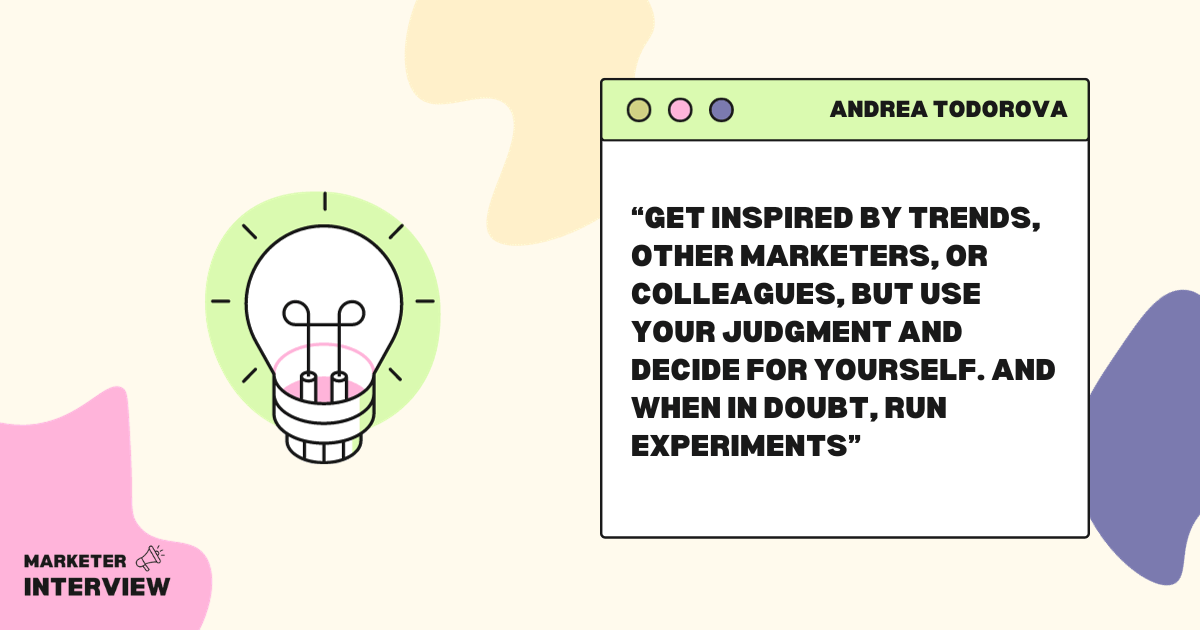
Sure. I’m proud of our latest project for Berlin’s digital product and venture-building agency, MVP Factory. They hired us to help them revamp their website. And in addition to the development and design services we offered, the project needed good marketing support.
So, the problem with their existing site was that they constantly needed the dev’s help for any changes and editing. And this was a significant blocker for their marketing team. They needed flexibility regarding upgrading and enhancing the site so it could evolve along with their strategy. We consulted them and helped them choose the right platform that would allow all of this and give the marketing team editing autonomy.
Another goal for the revamp was to improve the user journey on the site and extend the average session duration. So, together with their team, we placed strategic content elements that were specifically made to encourage the user to explore further.
We also migrated their analytics from Universal to GA4 and installed advanced tracking. This is how we ensured access to all the most critical insights supporting their decision-making process. We also integrated their website with their marketing stack and improved their SEO health.
I’m proud of this project because we met all the goals the client had and created a vital marketing asset. We accomplished this by working closely with them, carefully capturing their requirements, and analyzing the overall problem.
